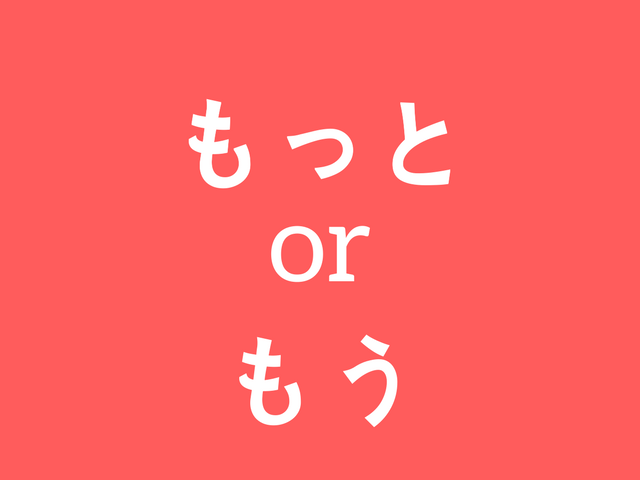When it comes to speaking in Japanese and expressing yourself, it really helps to know most of the common adverbs. And one of those words that you will use pretty much every day is the Japanese word for “more.”
There’s just one little problem: Is it もっと (motto) or is it もう (mou)? How do you say “more” in Japanese?
Well the typical answer to Japanese language questions also applies to this situation. And that answer is, “it just depends.”
Haha, perhaps that’s not what you wanted to hear, so let’s get into it in more detail so that you can understand when to use one over the other.
When to use もっと (motto) for “more”
When you simply look up the word for “more” in Japanese, 9/10 times you are going to see the word もっと pop up as the answer.
It can be used when talking about a quantity of some kind, such as:
- 写真もっと撮ればよかったな。
shashin motto toreba yokatta na.
I wish I’d taken more pictures.
Or it can be used with adjectives to increase the degree to which they apply, like:
- あなたはもっと理性的であるべきだ。
anata wa motto risei teki de aru beki da.
You should be more reasonable.
And of course it works when used with other adverbs as well. A common request you might want to memorize for when you are talking with native Japanese people is:
- もっとゆっくり話してください。
motto yukkuri hanashite kudasai.
Please speak more slowly.
Sometimes you will see もっと combined with another adverb in such a way that would be weird in English with just a direct translation. Here’s what I mean by that:
- もっと早く
motto hayaku
More early/soon.
When you encounter these types of situations, it’s better to think of もっと as the “er” part of our English words.
So change the translation of もっと早く from “more early” to just “earlier.”
Note that 早く can also mean “soon” in English, so もっと早く could mean “sooner” in certain contexts.
A closely related word to もっと is the Japanese word 最も (motto mo) which can also be written in just hiragana as もっとも.
The meaning of 最も is actually “most” and when it gets combined with adjectives in Japanese, it often gets translated as the “est” part of English words. Let me illustrate:
- あれは最も長い橋だよ。
are wa motto mo nagai hashi da yo.
That is the longest bridge!
The kanji 最 gets combined with a lot of words in Japanese to bring that meaning of an extreme, whether it’s a good thing or a bad thing. Actually, I should have said “whether it’s the best thing or the worse thing!”
You can learn more about it by reading this post.
Otherwise, it’s time to get to the other Japanese word for “more”
When to use もう (mou) for “more”
The もう (mou) is actually the word that’s used to mean “already” or “yet” in Japanese. And you will most likely see it used that way more times that not.
But there are occasions where that translation doesn’t quite work.
I’m sure you’ve encountered this next useful phrase when asking someone to repeat what they’ve said:
- もう一度、言ってください。
mou ichi do, itte kudasai.
Please say that one more time.
In these cases, c would be the word that translates as “more” or “again.”
I’ve only really seen もう used within a few phrases to mean “more” which are:
- もう一度 = One more time
- もうひとつ = One more (thing)
- もう少し = A little more
- もう一回 = Once more (occurrence)
A few of them are basically the same thing, but you could say that there are slight differences between them. For example, 度 is the counter used for “time” as in “one time, two times, three times, etc.” and ひとつ is the generic counter for one thing of any kind.
Still, you’ll hear and read もう一度 a lot, so it’s good to know that the もう part of it means “more; again” and not the normal usage of it as “already; yet”
But anyway, it’s good to know both of these words for “more” in Japanese since they are super common. Where do they rank within the top 1,000 used words in Japanese?
- もっと (motto) = #299
- もう (mou) = #52
I looked up the information on them by checking out the Japanese frequency dictionary that I’ve got. If you’re not sure what that is, it’s certainly worth reading up about.
5/1/18 UPDATE: Kaitlyn graciously provided an answer as to when you use もう or もっと for “more” in Japanese:

Thanks again Kaitlyn!
…
Now I wanna hear from you!
Did you learn anything new from this article? Did I leave anything out? Drop me a comment and let me know what you think!
Further Resources for Learning Japanese:
#3 Get My eBook (Secrets to Learning Japanese) for Free

またね!

Hey Nick,
Just wanted to comment and add that I heard from a native speaker and Japanese language teacher that they break it down as to whether you are talking about an exact quantity or not. So もう一つ、おねがいします。もう二時間ねたいです。For any other kind of more, “eat more, study more, more big etc” use もっと.
Hey Kaitlyn, thanks for the clarification!
I’ve also seen もうちょっと [mou chotto] used with the same meaning as もう少し [mou sukoshi] since those two words are almost identical.
You’re absolutely correct! I see that all the time too!
Man, I like having you around. You give me great content to add to my posts to make them better, lol! Thanks, I really do appreciate it!
I’ll also say that sometimes I see things translated into English that could be understood to mean “more” in Japanese, but not necessarily. Let me give an example:
もうやめて is sometimes translated in anime as “no more!” and that would be one way of understanding it, where 「もう」 means “more” in Japanese. But that exact phrase could also be interpreted as “stop already!” in English, which is a case where the common understanding of “already” for 「もう」 is true.
It’s one of those examples that really shows how the two languages don’t line up perfectly with one another and you have to understand the emotions, or feeling behind what’s being said in order to accurately translate it.
There’s also もう一回 [mou ikkai] that means “once more” since the kanji 回 is used as the counter for occurrences.
Oh yeah! I totally forgot about that one! I will add it to the list now for everyone to reference. Thanks for the comment!